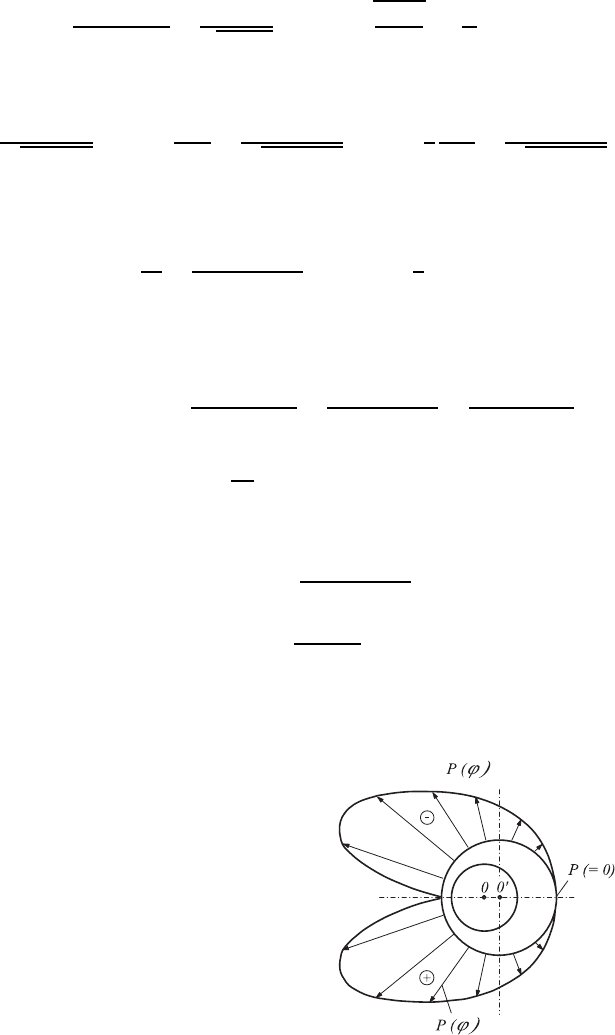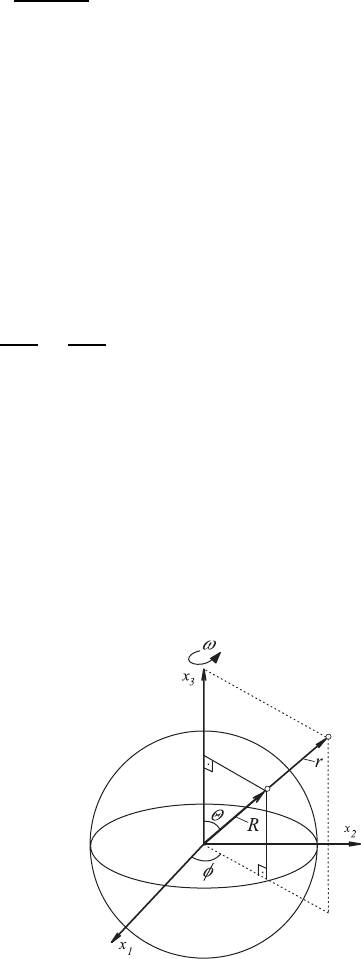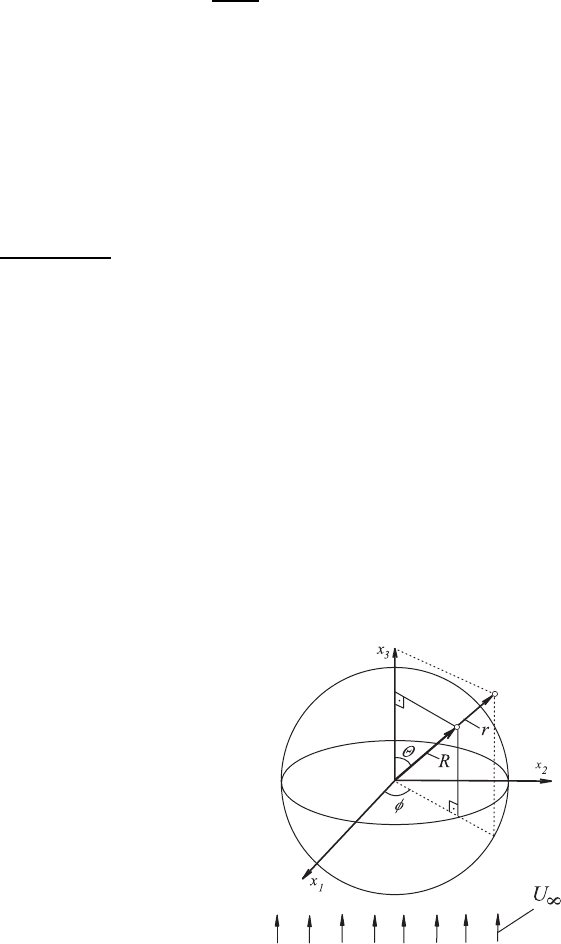Durst F. Fluid Mechanics: An Introduction to the Theory of Fluid Flows
Подождите немного. Документ загружается.


15.4 Theory of Lubrication in Roller Bearings 441
and because:
J
1
=
ϕ
#
0
dϕ
(α +cosϕ)
=
2
√
α
2
− 1
arctan
*
0
α − 1
α +1
tan
ϕ
2
+
(15.57)
one obtains for J
1
(ϕ = π), J
2
(ϕ = π), etc.
J
1
=
2π
(α
2
− 1)
; J
2
= −
dJ
1
dα
=
2πα
(α
2
− 1)
3
; J
3
= −
1
2
dJ
2
dα
=
π
!
2α
2
+1
"
(α
2
− 1)
5
.
(15.58)
Thus, from (15.51) one can compute
h
0
= e
J
2
J
3
=
2eα
!
α
2
− 1
"
(2α
2
+1)
with α =
δ
e
+1
. (15.59)
For the pressure distribution between pivot and bearing (Fig. 15.6), one can
compute
P (ϕ) − P
0
=6R
1
µU
⎡
⎣
ϕ
#
0
dϕ
(α +cosϕ)
2
=
2eα
!
α
2
− 1
"
(2α
2
+1)
ϕ
#
0
dϕ
(α +cosϕ)
3
⎤
⎦
.
(15.60)
From (15.52), one can see that
∂P
∂ϕ
=0forh = h
0
.
On defining with the angle ϕ
0
the angular position, where the pressure
shows an extremum, one obtains from (15.54)
e (α +cosϕ
0
)=
2eα
!
α
2
− 1
"
(2α
2
+1)
(15.61)
cos ϕ
0
= −
3α
2α
2
+1
. (15.62)
With this relationship, it has been shown that the points of highest and
lowest pressure are positioned on that half of the pivot circumference that
comprises the narrowest film.
Fig. 15.6 Distribution of the normal pressure
on the pivot of a roller bearing

442 15 Fluid Flows of Small Reynolds Numbers
The derived pressure distribution can be used to compute the share of the
pivot force resulting from the pressure actions only.
By integration, one obtains:
K
P
=
12πµR
2
1
U
e
2
(2α
2
+1)
√
α
2
− 1
. (15.63)
For determining the friction force, the momentum loss due to the motion of
the pivot can be stated as follows:
τ
rϕ
= −µ
1
r
∂U
r
∂ϕ
+
∂U
ϕ
∂r
−
ϕ
r
(15.64)
and because U
ϕ
= U and U
r
= 0 hold on the pivot surface r = R
1
,onecan
deduce for τ
rϕ
:
τ
rϕ
= −µ
3
∂U
ϕ
∂ξ
ξ=0
−
U
R
1
4
=
h
2R
1
∂P
∂ϕ
+
Uµ
h
+
Uµ
R
1
. (15.65)
With (∂P/∂ϕ)=6RµU(h − h
0
)/h
3
and h
0
inserted from (15.60), the
following results for the pressure gradient:
∂P
∂ϕ
=
6R
1
µU
e
2
1
(α +cosϕ)
2
−
2α(α
2
− 1)
(2α
2
+1)
1
(α +cosϕ)
3
(15.66)
and for τ
rϕ
τ
rϕ
= µ
U(4h − 3h
0
)
h
2
=
2µU
e
2
(α +cosϕ)
−
3α(α
2
− 1)
(2α
2
+1)
1
(α +cosϕ)
so that the torque can be computed as:
M =
2π
#
0
τ
rϕ
R
2
1
dϕ =
2µUR
2
1
e
2π(α
2
+2)
(2α
2
+1)
√
α
2
− 1
. (15.67)
In practice, the above equations can be employed as follows:
• When K
P
,µ,U,R,e,δ are known, the extremity of the pivot position and
also α can be determined by means of (15.63).
With (15.67), a friction factor can be introduced as
f =
M
K
P
R
1
=
δ
R
1
!
α
2
+2
"
3α
. (15.68)
As δ ≈ e holds in practice, one can deduce
f
0
≈
δ
R
1
; M ≈ f
0
K
P
R
1
. (15.69)

15.5 The Slow Rotation of a Sphere 443
With this value, friction moments can be computed with sufficient accuracy
for application in practice. For large values of α, the following holds for M:
M =
2πµUR
2
1
δ
. (15.70)
The above derivations have shown, in an exemplary way, that with the aid
of Stokes’ equations it is possible to treat technically relevant fluid flows in
such a manner that not only technically interesting insights result from the
derivations, but also quantitative results can be obtained.
15.5 The Slow Rotation of a Sphere
Considering the flow in a viscous fluid, which is caused by the slow rotation
of a small sphere, its Reynolds number can be determined as follows:
Re =
U
c
R
ν
=
ωR
2
ν
, (15.71)
where ω is the angular velocity of the rotation. Applying to the equations of
motion in spherical coordinates the conditions that exist due to the motion
of a sphere, as plotted in Fig. 15.7, then for
U
φ
= U
φ
(r, θ) (15.72)
the following differential equation holds, which represents an equation of
second order. This differential equation can be derived from the general
equations of motion in spherical coordinates:
Fig. 15.7 Flow in a viscous fluid due to the
rotation of a sphere around the x
3
axis

444 15 Fluid Flows of Small Reynolds Numbers
0=
1
r
2
∂
∂r
r
2
∂U
φ
∂r
+
1
r
2
1
sin θ
∂
∂θ
sin θ
∂U
φ
∂θ
+
1
r
2
1
sin
2
θ
∂
2
U
φ
∂φ
2
−
U
φ
r
2
sin
2
θ
+
2
r
2
sin θ
∂U
r
∂φ
+
2cosθ
r
2
sin
2
θ
∂U
θ
∂φ
. (15.73)
Because of the chosen rotational symmetry, the following terms are zero:
2
r
2
sin θ
∂U
r
∂φ
,
2cosθ
r
2
sin
2
θ
∂U
θ
∂φ
, and
1
r
2
1
sin
2
θ
∂
2
U
φ
∂φ
2
. (15.74)
Thus, (15.73) obtains the following form:
0=
∂
2
U
φ
∂r
2
+
2
r
∂U
φ
∂r
+
1
r
2
∂
2
U
φ
∂θ
2
+
1
r
2
cot θ
∂U
φ
∂θ
−
U
φ
r
2
sin
2
θ
. (15.75)
As boundary condition one can write U
φ
(R, θ)=Rω sin θ.
The aim of the solution of the flow problem is to find a function U
φ
(r, θ),
which fulfils the differential equation (15.75), and at the same time is able to
fulfil the stated boundary conditions. Such a function proves to be:
U
φ
= A(r)sinθ. (15.76)
Insertion of (15.76) into (15.75) yields:
d
2
A
dr
2
sin θ +
2
r
dA
dr
sin θ −
A
r
2
sin θ +
A
r
2
cos
2
θ
sin θ
−
A
r
2
1
sin θ
= 0 (15.77)
and as the differential equation for A(r)tobesolved:
d
2
A
dr
2
+
2
r
dA
dr
−
2A
r
2
=0. (15.78)
Integration of this differential equation yields
A(r)=C
1
r +
C
2
r
2
. (15.79)
Because U
φ
(r →∞,θ) = 0, it follows that C
1
=0.
From U
φ
(R, θ)=Rω sin θ =
C
2
R
2
sin θ it follows that C
2
= ωR
3
, and hence
one obtains as a solution for the velocity field of the fluid of the rotating
sphere:
U
φ
=
ωR
3
r
2
sin θ. (15.80)
In order to maintain this flow, imposed on the fluid by the rotating sphere, a
moment has to be imposed continuously, which can be computed as derived

15.6 The Slow Translatory Motion of a Sphere 445
below. From
τ
r,φ
= −µ
1
r sin θ
∂U
r
∂φ
+ r
∂
∂r
U
φ
r
(15.81)
it follows for the momentum release to the fluid by the rotating sphere:
τ
R,φ
= −µ
∂U
φ
∂r
−
U
φ
r
r=R
=3µω sin θ (15.82)
and for this the moment can be computed to be:
M = −
π
#
0
(3µω sin θ)(R sin θ)
!
2πR
2
sin θ
"
dθ (15.83)
M = −6πµωR
3
π
#
0
sin
3
θ dθ =8µπR
3
ω. (15.84)
Analogous to the above solution concerning the problem of the fluid motion
around a rotating sphere, the creeping fluid motion between two concentri-
cally positioned rotating spheres, with radii R
2
and R
1
and angular velocities
ω
2
and ω
1
, can be treated. The rotation is to take place again around the x
3
axis shown in Fig. 15.7. One obtains once more:
U
φ
= A(r)sinθ with A(r)=C
1
r +
C
2
r
2
. (15.85)
With the boundary conditions A(R
2
)=ω
2
R
2
and A(R
1
)=ω
1
R
1
,one
obtains as a solution for the induced velocity field:
U
φ
(r, θ)=
sin θ
r
2
(R
3
2
− R
3
1
)
7
ω
2
R
3
2
!
r
3
− R
3
1
"
− ω
1
R
3
1
!
r
3
− R
3
2
"8
(15.86)
and for the torque one can compute:
M = −8πµ(ω
2
− ω
1
)
R
3
2
R
3
1
(R
3
1
− R
3
2
)
. (15.87)
As far as the above solution is concerned, it was assumed that the eventually
occurring disturbances of the flow are attenuated by viscous effects, i.e. that
the computed solution is thus stable. On the basis of the treatment of creeping
flows, i.e. smallest Reynolds numbers, this assumption is justified, so that the
above analytically obtained results are very well obtained in experiments also.
15.6 The Slow Translatory Motion of a Sphere
The flow around a sphere is considered in this section, as induced by the
straight and uniform motion of the considered sphere in a viscous fluid. As
far as the equations to be solved are concerned, the problem is equivalent

446 15 Fluid Flows of Small Reynolds Numbers
to the flow around a stationary sphere in a viscous fluid. The specific fluid
motion is characterized by a sphere of radius R, the fluid velocity U
∞
,the
density ρ and the dynamic viscosity µ. From these, the Reynolds number of
the flow problem is computed with ν = µ/ρ:
Re =
RU
∞
ν
< 1. (15.88)
Stokes (1851) was the first to solve the problem of the translatory motion
of a sphere in a viscous fluid by considering only the pressure and viscosity
terms in the Navier–Stokes equations and neglecting all other terms in the
equations of motion. The same procedure is shown below. In this context,
a stationary sphere, located in the center of a Cartesian coordinate system,
is assumed in the subsequent considerations. For this flow case the following
boundary conditions hold:
U
1
= U
2
= U
3
=0 for r = R
with r =
x
2
1
+ x
2
2
+ x
2
3
, as shown in Fig. 15.8. This figure shows the sphere
whose center is at the origin of a Cartesian coordinate system. Relative to
this system, the coordinates of the spheres r, φ, θ are also indicated, which are
subsequently employed for the treatment of the flow around the considered
sphere. The surface of the sphere is located at r = R. Because of this assump-
tion of the location of the flow boundary, it is advantageous to take the basic
equations of fluid mechanics, for the solution of the flow around a sphere, in
spherical coordinates. In this way, the boundary conditions, imposed by the
presence of the sphere, can be included much more easily into the solution
of the flow problem, as if the treatment of the flow in Cartesian coordinates
was sought.
The following considerations are based on the diagram in Fig. 15.8. At
infinity, i.e. for r →±∞, the following values for the velocity components
will establish themselves:
Fig. 15.8 Flow around a sphere with
Cartesian and spherical coordinates

15.6 The Slow Translatory Motion of a Sphere 447
U
1
=0,U
2
=0,U
3
= U
∞
for r →∞. (15.89)
As already mentioned, for the solution of the basic equations for flows around
spheres, it seems obvious to employ the equations in spherical coordinates, in
order to be able to include the boundary conditions easily into the solution.
When considering the relevant terms for small Reynolds numbers, one ob-
tains the equations below. They can be derived from the general form of the
basic equations of fluid mechanics, using spherical coordinates. The resulting
equationsreadasfollowsforStokesflows:
∂U
r
∂r
+
1
r
∂U
θ
∂θ
+
2U
r
r
+
U
θ
cos θ
r
= 0 (15.90)
∂P
∂r
= µ
∂
2
U
r
∂r
2
+
1
r
2
∂
2
U
r
∂θ
2
+
2
r
∂U
r
∂r
+
cot θ
r
2
∂U
r
∂θ
−
2
r
2
∂U
θ
∂θ
−
2U
r
r
2
−
2cotθ
r
2
U
θ
(15.91)
1
r
∂P
∂θ
= µ
∂
2
U
θ
∂r
2
+
1
r
2
∂
2
U
θ
∂θ
2
+
2
r
∂U
θ
∂r
+
cot θ
r
2
∂U
θ
∂θ
+
2
r
2
∂U
r
∂θ
−
U
θ
r
2
sin
2
θ
. (15.92)
In spherical coordinates, the boundary conditions can be stated as follows:
r = R : U
r
(R, θ)=0 and U
θ
(R, θ) = 0 (15.93)
r →∞: U
r
→ U
∞
cos θ and U
θ
→−U
∞
sin θ. (15.94)
Again, the boundary conditions suggest solving the above differential
equations with the following solution ansatzes for U
r
and U
θ
:
U
r
(r, θ)=B(r)cosθU
θ
(r, θ)=−A(r)sinθ (15.95)
and for the pressure:
P (r, θ)=µC(r)cosθ. (15.96)
On inserting these ansatz functions (15.95) and (15.96) into the above
differential equations (15.90)–(15.92), one obtains:
dB
dr
+
2(B −A)
r
= 0 (15.97)
dC
dr
=
d
2
B
dr
2
+
2
r
dB
dr
−
4(B −A)
r
2
(15.98)

448 15 Fluid Flows of Small Reynolds Numbers
C
r
=
d
2
A
dr
2
+
2
r
dA
dr
+
2(B −A)
r
2
. (15.99)
From the boundary conditions for flows around spheres, the following
boundary conditions result for the functions A, B and C:
A(R)=0,B(R)=0,A(∞)=U
∞
, and B(∞)=U
∞
. (15.100)
The solution steps for the differential equations (15.97)–(15.99) can be stated
as follows
From (15.97) it follows that:
A =
1
2
r
dB
dr
+ B. (15.101)
Inserting A into (15.99) results in:
C =
1
2
r
2
d
3
B
dr
3
+3r
d
2
B
dr
2
+2
dB
dr
. (15.102)
This differential equation can be differentiated with respect to r and the
result can be inserted into (15.98) to yield:
r
3
d
4
B
dr
4
+8r
2
d
3
B
dr
3
+8r
d
2
B
dr
2
− 8
dB
dr
=0. (15.103)
The resulting Euler differential equation can be solved by integration with
particular solutions being sought of the form B = cr
k
.IfoneinsertsB = cr
k
into the above differential equations, an equation of fourth order for k results:
k(k −1)(k − 2)(k − 3) + 8k(k −1)(k − 2) + 8k(k −1) − 8k =0
or, written in a somewhat simplified form:
k(k − 2)(k +3)(k + 1) = 0 (15.104)
so that the following k-values result as solutions:
k =0,k=2,k= −3andk = −1. (15.105)
Thus, for B(r) the following general solution can be given:
B(r)=
C
1
r
3
+
C
2
r
+ C
3
+ C
4
r
2
. (15.106)
From the equations for A(r) (15.101) and C(r) (15.102) one obtains:
A(r)=−
C
1
2r
3
+
C
2
2r
+ C
3
+2C
4
r
2
(15.107)
C(r)=
C
2
r
2
+10C
4
r. (15.108)

15.6 The Slow Translatory Motion of a Sphere 449
Inserting for A(r), B(r)andC(r) the boundary conditions (15.100), the
integration constants C
1
, C
2
, C
3
and C
4
can be determined:
C
1
=
1
2
U
∞
R
3
; C
2
= −
3
2
U
∞
R; C
3
= U
∞
; C
4
=0. (15.109)
Thus, for U
r
(r, θ), U
θ
(r, θ)andP (r, θ) the following solutions result:
U
r
(r, θ)=U
∞
cos θ
1 −
3
2
R
r
+
1
2
R
3
r
3
(15.110)
U
θ
(r, θ)=−U
∞
sin θ
1 −
3
4
R
r
−
1
4
R
3
r
3
(15.111)
P (r, θ)=−
3
2
µ
U
∞
R
r
2
cos θ. (15.112)
With these relationships, the solution for the velocity and pressure fields for
the flow around a sphere are available. Although obtained by solving a set of
simplified differential equations, which was obtained as a reduced set from the
Navier–Stokes equations by neglecting the acceleration terms, an important
set of results emerged for U
r
, U
θ
and P. However, the solutions obtained hold
only for Re < 1.
When looking at the different momentum transport terms τ
rr
and τ
rθ
of
the flow problem discussed here, one obtains for ρ = constant:
τ
rr
= −µ
2
∂U
r
∂r
for r = R is
∂U
r
∂r
r=R
= 0 (15.113)
and τ
r,θ
= − µ
!
1
r
∂U
r
∂θ
+
∂U
θ
∂r
−
U
θ
r
"
. From this, one obtains for r = R,be-
cause U
r
= U
θ
= 0 and therefore also
∂U
r
∂θ
=0and
∂U
θ
∂θ
=0,atthesurface
of the sphere the following expression for the pressure:
P =
3
2
µU
∞
R
cos θ (acts on each point vertically (15.114)
to the surface of the sphere).
In addition,
τ
r,θ
= −µ
∂U
θ
∂r
= −
3µU
∞
2R
sin θ (acts on each point tangentially (15.115)
to the surface of the sphere).
The drag force F
D
can thus be computed:
F
D
=
##
F
(P cos θ − τ
r,θ
sin θ)dF (15.116)
F
D
= −
π
#
0
3
2
µU
∞
R
cos
2
θ +
3µU
∞
2R
sin
2
θ
!
2πR
2
sin θ
"
dθ (15.117)

450 15 Fluid Flows of Small Reynolds Numbers
or rewritten and integrated:
F
D
= −
π
#
0
3πµU
∞
R(sin θ)dθ = −3πµU
∞
R (−cos θ)
4
π
0
(15.118)
F = −6πµU
∞
R .
The integration over the pressure acting on the surface of the sphere, and
over the momentum loss to the wall, yields the Stokes drag force W. Here it
is of interest that the share of force coming from the pressure:
F
D
= −
π
#
0
P cos θ2πR
2
sin θ dθ = −3πµU
∞
R
π
#
0
cos
2
θ sin θ dθ (15.119)
with F
D
= − 2πµU
∞
R amounts only to one-third of the total drag, i.e. two-
thirds of the drag force results thus from the molecular momentum input
to the surface of the sphere. This underlines the importance that must be
attached to the viscosity terms in the Navier–Stokes equations for the solution
of practical flow problems at small Reynolds numbers.
In order to determine now the velocity components in Cartesian coordi-
nates, i.e. U
1
, U
2
and U
3
, the following equations for the transformation of
coordinates are employed:
x
1
= r cos θ ; U
1
= U
r
cos θ − U
θ
sin θ (15.120)
x
2
= r sin θ cos φ ; U
2
= U
r
sin θ cos φ + U
θ
cos θ cos φ − U
φ
sin φ (15.121)
x
3
= r sin θ sin φ ; U
3
= U
r
sin θ sin φ + U
θ
cos θ sin φ + U
φ
cos φ.(15.122)
With these equations one obtains:
U
1
= U
∞
1 −
3
4
R
r
−
1
4
R
3
r
3
−
3
4
U
∞
Rx
2
1
R
3
1 −
R
2
r
2
(15.123)
U
2
= −
3
4
U
∞
Rx
1
x
2
R
3
1 −
R
2
r
2
(15.124)
U
3
= −
3
4
U
∞
Rx
1
x
3
R
3
1 −
R
2
r
2
. (15.125)
For the solution of the Stokes flow around spheres, the above simplified flow
equations (15.90)–(15.92) were employed. To be able to assess how large the
neglected terms of the Navier–Stokes equations are in comparison with the
terms considered in the solution, the acceleration:
ρ
DU
1
Dt
θ=0
= ρ
U
r
∂U
r
∂r
θ=0
=
3ρ
2
U
2
∞
r
2
R
1 −
R
2
r
2
1 −
3R
2r
+
R
3
2r
3
(15.126)
